EXHIBITIONS
EXHIBITIONS
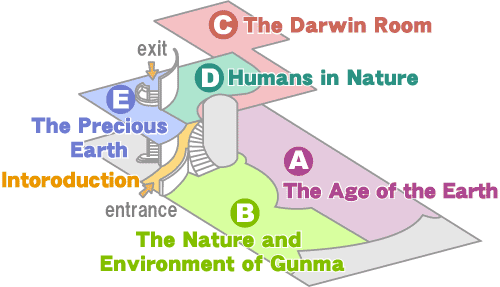
Introduction
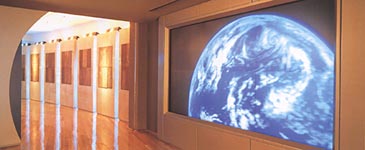
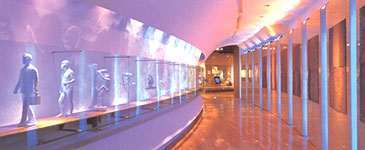
A model array of the life evolution
Section A “The Age of the Earth”
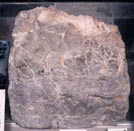
Stromatolite is a rock formed by small cyanobacteria, shaped like a paraphysis. The aggregate of cyanobacteria secretes a mucus, which forms limestone of a stripe-like structure by catching accumulated particles and depositing calcium carbonate. Naturally formed stromatolites are found in Australia and Africa.
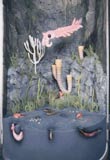
Excavation in shale layers formed during the Cambrian period (the first of the Palaeozoic era) has yielded fossils far greater in number than in older beds. This phenomenon is ascribed to the rapid evolution of marine invertebrates (called the Cambrian explosion), which took place during the earlier Palaeozoic era.
Burgess shale fauna, comprising the fossils of animals belonging to about 150 exotic species, are among the typical fossils dating back to the Cambrian period; the fauna were discovered in the U.S. in 1909 by C. D. Walcott. Among these animals, which swam over the sea bottom, are Opabinia, a creature with five eyes and a long nose, resembling that of an elephant; and Anomalocaris, a carnivorous animal whose name means “strange lobster.” It is thought that most of the ancestors of present-day animals and plants appeared during the Cambrian period.

Dimetrodon is a reptile with features resembling those of a mammal. Appearing in the Carboniferous period, it is one of the most well-known of its kind. With long spinal processes, protruding from the spinal column, a Dimetrodon looks like a ship with a sail on its back.
Various theories have been proposed to explain the function of this sail-like feature. A widely accepted theory holds that it served to adjust body heat. The exhibit was made by putting together actual fossils.
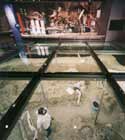
This exhibit illustrates the excavation of a Triceratops in South Dakota, U.S. Triceratops, a Ceratopsia, is characterized by three large horns. The exhibit shows actual fossils of the Triceratops in actual arrangement, except for the head, which is not suitable for exhibition due to instability.
Shown above the bone bed is the entire frame of the Triceratops, designed using a cast modeled after the actual fossils.
Visitors can enjoy a thrilling, bird’s-eye view of the bone bed (placed about three meters under the floor), through reinforced glass.

This exhibit is part of the actual skeleton of a Camarasaurus―a dinosaur of the late Jurassic period. The skeleton was excavated in Bonecabin quarry, Wyoming ,and restored in 1993. Studies have found that the excavated skeleton represents about 65% of the original skeleton. Its size, the degree of cranial cohesion and the form of the spinal process on the caudal vertebra indicate that the skeleton is that of an old female dinosaur. The skeleton clearly shows the marks of a bone disease and predator’s bitemark.
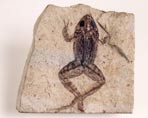
The Kabutoiwa Layer is a layer at the bottom of a lake near Mt. Kabutoiwa in Nanmoku Village. This layer consists of multiple thin tuff sub-layers. The layer is assumed to have been formed during the late Miocene epoch. Excavated from the layer are fossils of frogs, tadpoles, and birds and other vertebrates (e.g. fossils of bird feathers).
This exhibit is the fossil of a frog excavated from the Kabutoiwa Layer. It shows the shapes of the frog bones, as well as the color pattern of the frog’s spotted skin. The fossil is one of the few frog fossils showing the skin color patterns. It is highly valuable, given the fact that frog fossils showing the impressions of skin are rare.
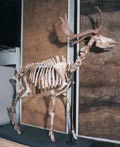
Yabe’s Giant Fallow Deer, now extinct, were a variety of deer far larger than recent deer. The exhibited skeleton of a Yabe’s Giant Fallow Deer comprises six fossils of roughly the same size, found separately at different sites in Japan. The antler is a replica of a fossil found in 1797 in Kamikuroiwa, Tomioka City, Japan, the oldest ever recorded in Japan. The actual fossil, as well as a record and minute illustration of the fossil, made at the time of excavation, are still kept in the collection of Jagu Jinja shrine in Tomioka city.
Section B “The Nature and Environment of Gunma”
The eastern and middle parts of Gunma Prefecture are hilly areas up to 600 m above sea level. So these areas belong to the warm temperate zone. Natural vegetation there would be evergreen broad-leaved forests. But the vegetation there has almost totally disappeared, due to human activities since ancient times. Remnants of natural vegetation are found as forests in the precincts of temples and shrines, or on steep slopes. Plains and plateaus are used as urban areas, farms or paddies. Dandelions, tall goldenrods and other naturalized species account for a significant part of vegetation on the plains and plateaus. The foothills are mostly planted with Japanese cedars and cypresses. However, coppices, mostly consisting of Sawtooth oak and Conara oak, remain in some areas.
These coppices are secondary forests formed artificially, as sources of firewood. There, plants of northern origin [e.g. dogtooth violets] coexist with those of southern origin [e.g. “Shunran” orchid].
The diorama shows a coppice in early spring. Leaves of tall trees have not emerged. Evergreen trees―such as “Shirakashi” oaks and spearflowers―exist as remnants of natural vegetation. Dogtooth violets, anemones and violets flower on the ground. The flowering season of “Shunran” orchid has ended. The season of fresh green leaves is about to arrive, and soon the call of japanese pheasants will be heard.
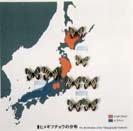
Small gifu butterflies are found in the Hokkaido, Tohoku and Shinetsu regions of Japan. In the Kanto region, they live only in the Mt. Akagi area. The butterflies grow wings in early spring, in coppices in the cool temperate zone. They mate and lay eggs before tree leaves grow thick. Larvae grow rapidly, eating “Usubasaishin” [a variation of Dutchman’s-pipe], and become chrysalides, at about the time when forests are darkened by thickly grown leaves. Like dogtooth violets, the butterflies are called spring ephemeral, due to their life cycle.
Since the characteristics [e.g. wing pattern] of the small gifu butterflies vary widely according to region, and they have a peculiar life cycle,the butterflies have decreased rapidly due to unrestrained collecting. In Gunma Prefecture, they are designated a Natural Monument, for protection.
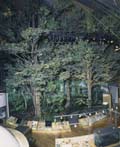
Some areas in Gunma Prefecture are mountain areas 600 to 1,600 meters above sea level. The weather in these areas is favorable for the development of deciduous broad-leaved forests. In the past, beech forests [of the type characteristic of the Pacific side of Japan] were found in mountain areas in Gunma, such as those in the Tano Mountains, Mt. Asamakakushi, Mt. Sukai, and the Ashio Mountains. At present, partly as a result of tree planting, beech forests remain only in a small number of areas, such as on Mt. Suwa. In areas on Mt. Akagi, beech forests have been superseded by natural oak forests.
The exhibits, in a 12 m-high room, show the view of a beech forest [of the type characteristic of the Japan Sea side of Japan] on the northern side of Mt. Hotaka. Beech trunks were transported from the site of the Naramata Dam, located deep in the mountain. You see Acanthopanax sciadophylloides and Acer japonicum in the sub-tree zone; and Viburnum furcatum [white flowers], rowans, and Lindera umbellata var. membrancea in the shrub zone. Viola brevistipulata and other flowers are found on the forest bed.
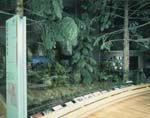
Areas in Gunma Prefecture, more than 1,600 meters above sea level, belong to the subalpine zone. Some of these areas are mature coniferous forests where firs predominate. On the other hand, Abies Mariesii predominate in some areas with heavy snowfalls [mountain areas near Oze, or east of the Shiga Heights], whereas Abies Veitchii are dominant in areas with less snowfall [those on Mt. Kusatsu Shirane or Nikko Mountains].
The diorama represents a forest of Abies Veitchii and Abies Mariesii on Mt. Nikko Shirane [in Katashina Village]. Besides Abies Veitchii and Abies Mariesii [both variations of fir], the forest includes Japanese hemlocks and Japanese spruces [both also belonging to the pine family]. Found on the forest bed are white flowers, such as cornelian cherries and Oxalis Acetosella. In addition, you can see Oplopanax japonicus, with thorns thickly growing on their leaves and stems. All of these plants characterize the subalpine zone
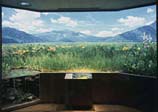
The Ozehagara moor is about 1,400 m above sea level. Surrounded by mountains, it extends about 6 km east-west, and about 2 km north-south.
The moor comprises bog, mire and fen, classified according to vegetation. At the moor, visitors can observe plants of each level.
The diorama shows the Ozegahara moor in late July. Skunk cabbages and rabbit ear irises can be seen at the fen, and day lilies at the mire. Moorworts can be seen in the raised topography called Bult, and insectivorous sundew plants in a basin of another type, called Schlenke. Among the sundew plants, one is capturing a dragonfly. The diorama also shows the underwater portion of a candock, growing in a pool called Chito.
Section C “The Darwin Room”
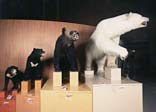
Generally, animals living in cold areas are larger than their counterparts in warmer areas. This tendency is called Bergmann’s Rule. It is assumed to be a result of the adaptation of animals to cold environments.
For instance, the body of a polar bear is larger than that of any other kind of bear. The body surface area, per unit weight, of a large animal is smaller than that of a small animal. Consequently, heat emitted from the body of a large animal is relatively small, compared to a small animal.
The exhibits show the bodies of a Malay bear, a Japanese bear, a brown bear, and a Polar bear. Though they do not belong to the same species, they are all bears, of different body sizes. This difference has arisen from the temperature differences in the regions where they live.
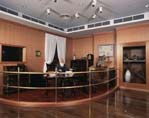
Charles Darwin was born in Britain in 1809. At the age of 22, he made a round-the-world voyage on the HMS Beagle. Based on this experience, he devised the famous theory of natural selection. The basic tenets of Darwin’s theory are supported by scientists today.
However, it is little known that Darwin was a naturalist interested in plants, minerals and all other elements of nature. The section “The Room of Darwin” is so named to suggest this side of Darwin. Here, Robot Charlie―modeled after Darwin―explains, in plain terms, exhibited materials and facts about evolution.
Section D “Humans in Nature”
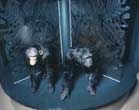
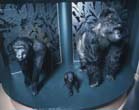
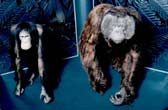
Homo sapiens is one of the approximately 200 species constituting the primates. Primates are characterized by their opposing thumb; as well as by such features as flat nails, fingerprints, three-dimensional vision, and color sense.
This display features a turntable carrying stuffed orangutans, gorillas and chimpanzees―male and female specimens paired for each kind of animal. The exhibits show the beautiful black hair of the chimpanzee, and the white hair on the back of a male gorilla (called a “silverback”). The specimens also indicate the difference in body size among the primates. The difference between male and female primates of the same species is referred to as that between two sexual types. For orangutans and gorillas, the male bodysize is about twice that of the female. Additionally, male canine teeth are larger than those of the female.
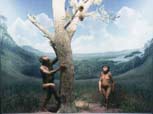
Australopithecus afarensis are anthropoids that lived in East Africa about 3.8 to 3 million years ago. They are presumed to have been 1.0 to 1.5 meters high, and weighed 30 to 70 kilograms. Fossils of Australopithecus afarensis, as well as their footmarks (found in Laetoli, Tanzania), suggest that they walked upright, like humans do.
The head of an Australopithecus afarensis is characterized by its low, flat frontal portion, and its protruding eye sockets. These anthropoids are also known for their canine teeth, which are larger than those of humans. Their brain has a capacity of about 400 to 500 milliliters, not significantly different from that of the orangutan, gorilla, chimpanzee or other existing anthropoids.
Section E “The Precious Earth”
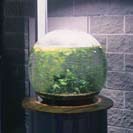
The Eco-ball, an experimentally designed closed ecosystem, features water plants that produce food and oxygen; fish, shrimps and shellfish that consume oxygen and food and generate carbon dioxide and organic substances (e.g. excrement); and microorganisms that decompose the excrement, waste and other organic substances. These organisms live in complex relationships with each other. The electric bulb installed on the Eco-ball provides the light necessary for photosynthesis by the water plants. It also heats the Eco-ball. The temperature of the Eco-ball is sometimes influenced by room temperature.
The exhibit is modeled after the Earth.





